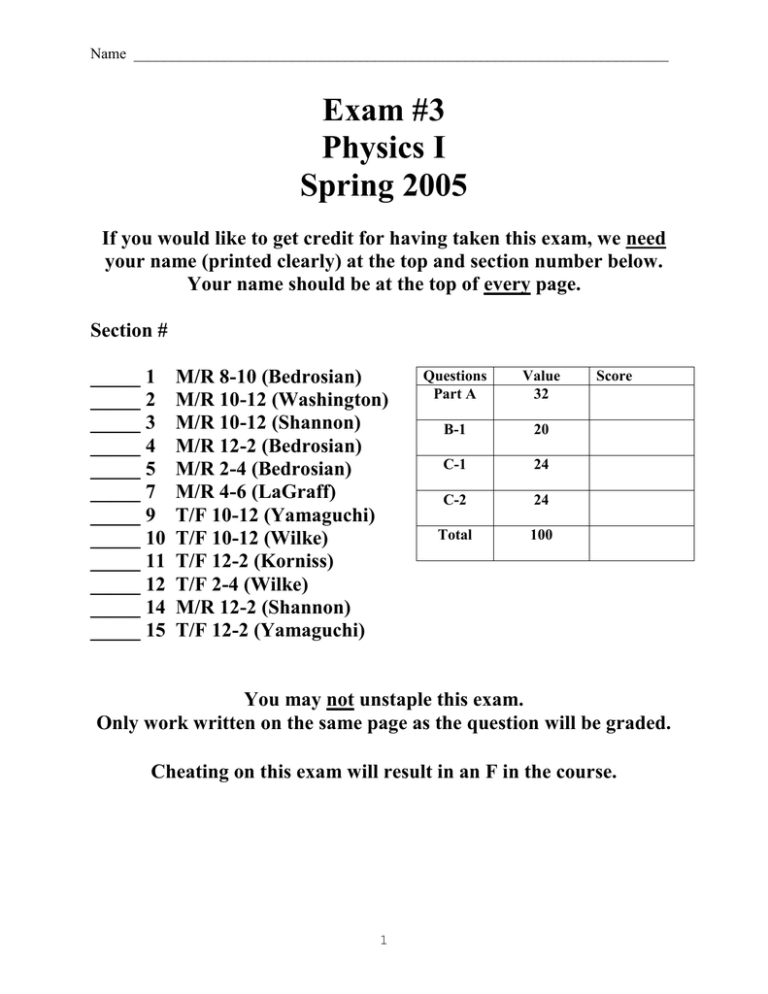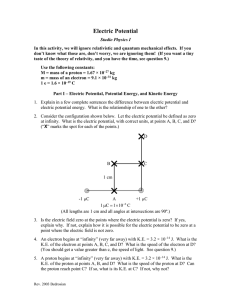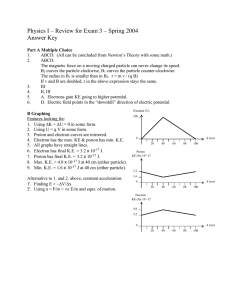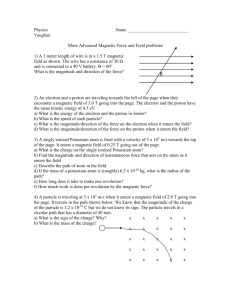Exam #3 Physics I Spring 2005
advertisement

Name _______________________________________________________________________ Exam #3 Physics I Spring 2005 If you would like to get credit for having taken this exam, we need your name (printed clearly) at the top and section number below. Your name should be at the top of every page. Section # _____ 1 _____ 2 _____ 3 _____ 4 _____ 5 _____ 7 _____ 9 _____ 10 _____ 11 _____ 12 _____ 14 _____ 15 M/R 8-10 (Bedrosian) M/R 10-12 (Washington) M/R 10-12 (Shannon) M/R 12-2 (Bedrosian) M/R 2-4 (Bedrosian) M/R 4-6 (LaGraff) T/F 10-12 (Yamaguchi) T/F 10-12 (Wilke) T/F 12-2 (Korniss) T/F 2-4 (Wilke) M/R 12-2 (Shannon) T/F 12-2 (Yamaguchi) Questions Part A Value 32 B-1 20 C-1 24 C-2 24 Total 100 Score You may not unstaple this exam. Only work written on the same page as the question will be graded. Cheating on this exam will result in an F in the course. 1 Name _______________________________________________________________________ On this exam, please neglect any relativistic and/or quantum mechanical effects. If you don’t know what those are, don’t worry, we are neglecting them! On all multiple-choice questions, choose the best answer in the context of what we have learned in Physics I. On graphing and numerical questions, show all work to receive credit. Part A – Multiple Choice – 32 Points Total (8 at 4 Points Each) _______1. A) B) C) D) In comparison to the magnitude of the electric force of attraction between an electron and a proton, the magnitude of the gravitational attraction between an electron and a proton is much smaller than the electric force of attraction. is about the same as the electric force of attraction. is much larger than the electric force of attraction. could be larger or smaller depending on how far apart they are. _______2. The earth orbits the sun along an elliptical path with one focal point at the center of the sun. When the earth is at its closest point to the sun along its path, the gravitational potential energy of the sun-earth system A) is at its minimum. B) is at its maximum. C) has the same constant value it keeps for the entire orbit. _______3. A) B) C) D) Particle A with charge +5 x 10–9 C exerts an electrostatic force on particle B with charge –2 x 10–9 C one centimeter away. The magnitude of this force is FAB. Particle B exerts an electrostatic force on particle A with magnitude FBA. Which statement below is true? FAB < FBA. FAB > FBA. FAB = FBA. There is not enough information to decide A-C above. _______4. Electric equipotential lines in a certain region of space are shown in the figure below, along with their respective values. What is the direction of the electric field in this region of space? A) . E) . B) . F) . C) . G) . D) . H) . V = 10 V=5 V=0 2 Name _______________________________________________________________________ _______5. A) B) C) D) E) F) +X. –X. +Y. –Y. +Z. –Z. _______6. A) B) C) D) E) F) +X. –X. +Y. –Y. +Z. –Z. _______7. The figure below shows an electron moving in the +X direction in a region where the electric field (E) points in the +Y direction. What is the direction of the electric force on the electron? electron v E Y (Z out of page) X The figure below shows an electron moving in the +X direction in a region where the magnetic field (B) points in the +Y direction. What is the direction of the magnetic force on the electron? electron v B Y (Z out of page) X The figure below shows the respective paths taken by two particles, A and B, in a region containing a constant, uniform magnetic field directed into the plane of motion (into the page). There is no electric field. Both particles have charge +e. What can we correctly conclude about particles A and B? A) The mass of A > the mass of B. B) The speed of A > the speed of B. C) The magnitude of momentum of A > B the magnitude of momentum of B. A D) The kinetic energy of A > the kinetic energy of B. E) There is not enough information to conclude any of A-D above. _______8. A) B) C) D) Select the correct statement(s) about the magnetic force on a moving charged particle from the list below. Select all that are correct or put “0” if none are. If the force is not zero, its direction is at a right angle to the particle’s velocity. If the force is not zero, its direction is at a right angle to the magnetic field. If the magnetic field and particle’s velocity are in the same direction, the force is zero. The magnetic force cannot change the particle’s kinetic energy. 3 Name _______________________________________________________________________ B-1 – Graphing – 20 Points An electron has an initial velocity of (1.0 x 10+6 i + 3.5 x 10+6 j) m/s at location (0,0) just above a metal plate with an electric potential of 50 V. There is another metal plate 5.0 cm away in the +Y direction with an electric potential of 0 V. Assume that the electric field is uniform and static, meaning it is constant in space and time. Only the electric force acts on the electron. (a) Show that the electric field between the plates is (+1000 j N/C). (b) Plot the trajectory (path in X and Y space) of the electron from the initial position to the point at which it hits either the upper or lower plate – you decide which one. From your plot it should be clear what is the shape of the path, where it ends, and any minimum or maximum points with their numerical values. Hint: You do not need to solve a quadratic equation to solve this problem. Upper Plate, V = 0 Y X 5 4 3 2 1 0 0 2 4 6 8 10 12 14 Lower Plate, V = 50 Volts 4 16 18 20 cm Name _______________________________________________________________________ Problem C-1 (24 Points) Three particles are (separately) accelerated from rest beginning at potential V0 = 30,000 volts and ending at potential 0 volts, where they enter a uniform magnetic field of 0.50 T directed into the page as shown in the figure below. The particles initially are moving to the right on the page and then follow the circular paths marked as A and B. The three particles are a proton with charge +e and mass mp, a deuterium nucleus with charge +e and mass 2 mp, and a helium nucleus with charge +2 e and mass 4 mp. Determine the radii of paths A and B and determine which path each particle takes. Your calculations should show clearly why there are only two distinct paths for the three particles. A B magnetic field into the page Particles start here A. Radius of Path A = ______________________________________________ units ________ B. Radius of Path B = ______________________________________________ units ________ C. Path that the proton takes (A or B): _______ D. Path that the deuterium nucleus takes (A or B): _______ E. Path that the helium nucleus takes (A or B): _______ 5 Name _______________________________________________________________________ Problem C-2 (24 Points) Four point charges, A, B, C, and D, are arranged at the corners of a square 0.6 m on a side as shown in the figure below. Charges A, B, and C are +2.0 x 10–9 C and charge D (the one on the lower left) is –2.0 x 10–9 C. Assume the electric potential is zero at infinity. Find the electric field (X and Y components) and electric potential at the center of the square. A (-0.3,+0.3) B (+0.3,+0.3) Y X D (-0.3,-0.3) C (+0.3,-0.3) Electric Field X Component: ________________________________________ units ________ Electric Field Y Component: ________________________________________ units ________ Electric Potential: ________________________________________ units ________ 6 Name _______________________________________________________________________ Formula Sheet for Homework and Exams – Page 1 of 2 U Fcons dx 1. v v 0 a t t 0 23. 2. x x 0 v 0 ( t t 0 ) 12 a ( t t 0 ) 2 24. U g m g (y y 0 ) 3. x x 0 12 ( v0 v)( t t 0 ) 25. U s 12 k ( x x 0 ) 2 4. x x 0 v( t t 0 ) 12 a ( t t 0 ) 2 26. 27. 28. K U Wnoncons s r v tangential r 29. a tangential r 6. v 2 v 02 2a x x 0 F Fnet m a 7. T 8. a centripetal 5. 9. 10. 11. 12. 13. 14. 15. 16. 17. 18. 19. 20. 2r v v2 2 r r a radial a centripetal p mv dp F Fnet d t J Fnet dt p P pi dP Fext dt 30. 0 t t 0 31. 0 0 ( t t 0 ) 12 ( t t 0 ) 2 32. 0 12 (0 )( t t 0 ) 33. 0 ( t t 0 ) 12 ( t t 0 ) 2 2 02 2 0 35a. a b a b sin( ) a b a y b z a z b y î 35b. a z b x a x b z ĵ a x b y a y b x k̂ 34. 36. 37. M mi 1 1 x cm m i x i y cm m i y i M M P M v cm a b a b cos() a x b x a y b y a z b z W Fd W F dx 21. K 12 m v 2 12 m (v x v y ) 22. K f K i Wnet 2 38. 39. 40. 41. 42. 43. 2 I m i ri 2 K rot 12 I 2 W d r F dL I d t l r p L l i L I 44x. m1 v1, x ,before m 2 v 2, x ,before m1 v1, x ,after m 2 v 2, x ,after 44y. m1 v1, y ,before m 2 v 2, y ,before m1 v1, y ,after m 2 v 2, y,after 44z. m1 v1,z ,before m 2 v 2,z ,before m1 v1,z ,after m 2 v 2,z ,after 45a. v1,f m1 m 2 2 m2 v1,i v 2 ,i m1 m 2 m1 m 2 45b. 7 v 2,f 2 m1 m m1 v1,i 2 v 2 ,i m1 m 2 m1 m 2 Name _______________________________________________________________________ Formula Sheet for Homework and Exams – Page 2 of 2 m m 46a. | F | G 1 2 2 r m m 46b. F G 1 2 2 r̂ r 1 | q1 || q 2 | 47a. | F | 4 0 r2 1 q1 q 2 47b. F (r̂ ) 4 0 r 2 1 | qi | 48a. | E i | 4 0 ri 2 1 qi (r̂i ) 48b. E 4 0 ri 2 49. F q E 50. 51. 52. 1 qi 4 0 ri U qV V E dx V V x V 53y. E y y 54. F q v B mv 55. r qB 53x. E x Useful Constants (You can use the approximate values on tests.) Universal Gravitation Constant G 6.67310 11 N m 2 kg 2 6.67 10 11 Electrostatic Force Constant 1 8.987551788 10 9 N m 2 C 2 9.0 10 9 4 0 Magnetic Constant 0 4 10 7 H m 1 1.26 10 6 Speed of Light in Vacuum c 2.99792458 10 8 m s 1 3.010 8 Charge of a Proton e 1.602176462 10 19 C 1.6 10 19 Electron-Volt Conversion Constant 1eV 1.602176462 10 19 J 1.6 10 19 Mass of a Proton m p 1.6726215810 27 kg 1.67 10 27 Mass of an Electron m e 9.10938188 10 31 kg 9.110 31 8






